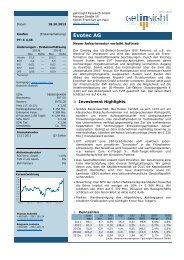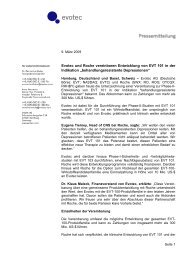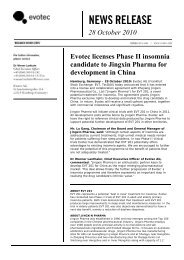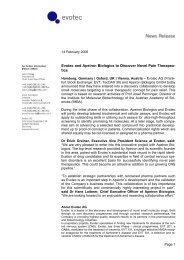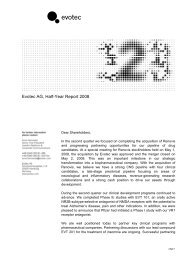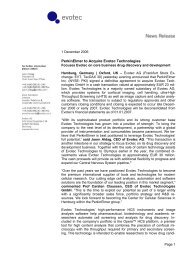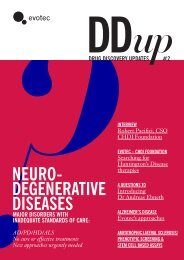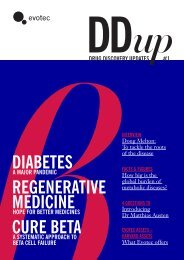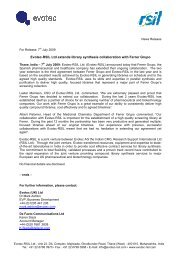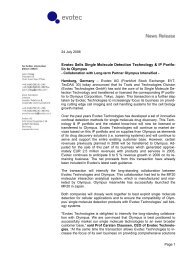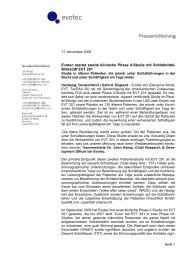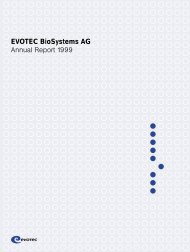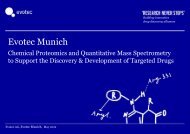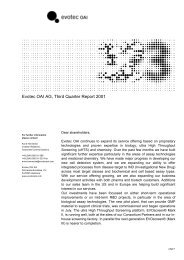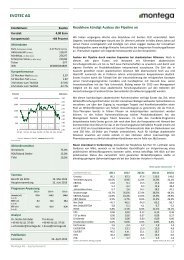NEURO- DEGENERATIVE DISEASES - Evotec
NEURO- DEGENERATIVE DISEASES - Evotec
NEURO- DEGENERATIVE DISEASES - Evotec
You also want an ePaper? Increase the reach of your titles
YUMPU automatically turns print PDFs into web optimized ePapers that Google loves.
nEuro-<br />
DEgEnEratIvE<br />
DIsEasEs<br />
maJor DIsorDErs wItH<br />
InaDEquatE stanDarDs oF carE:<br />
AD/PD/HD/ALS<br />
No cure or effective treatments<br />
New approaches urgently needed<br />
DDup<br />
Drug DIscovEry upDatEs #2<br />
IntErvIEw<br />
Robert Pacifici, CSO<br />
CHDI Foundation<br />
EvotEc – cHDI FounDatIon<br />
Searching for<br />
Huntington’s Disease<br />
therapies<br />
4 quEstIons to<br />
Introducing<br />
Dr Andreas Ebneth<br />
alzHEImEr’s DIsEasE<br />
<strong>Evotec</strong>’s approaches<br />
amyotropHIc latEral sclErosIs/<br />
pHEnotypIc scrEEnIng &<br />
stEm cEll basED assays
em cells<br />
eporter<br />
e E N<br />
s<br />
e with<br />
h<br />
content & contact<br />
5 12<br />
IntErvIEw Dr Pacifici cHDI – collaboratIon<br />
q u a n t i T A t i v e<br />
P C R d A T A<br />
e microglia<br />
ell line<br />
16 alzHEImEr –<br />
24<br />
E T d<br />
IntroDuctIon Dr Ebneth<br />
Optional: FACS-sort<br />
GFP-positive motor neurons<br />
activate with LPS/IFN-γ<br />
into inflammatory state<br />
No synthesis<br />
kEy topIc at EvotEc<br />
b i o I n f O r m a t i o N<br />
t O o l s / d a t a b a s e s<br />
L i t e r a t u r e /<br />
p a t e n t d a t a<br />
v a l i d a t i o n<br />
E x p e r i m e n t s<br />
20<br />
als anD pHEnotypIc<br />
scrEEnIng<br />
Steadily increaSing patient numberS<br />
million<br />
9<br />
8<br />
7<br />
6<br />
5<br />
4<br />
3<br />
2<br />
1<br />
0<br />
2011 2015 201<br />
14<br />
Alzheimer<br />
Parkinson<br />
Multiple<br />
Sclerosis<br />
FCS differentiate<br />
into astrocytes<br />
Facts & FIgurEs<br />
Alzheimer<br />
22<br />
stEm cEll basED assays<br />
For your FuturE<br />
DD proJEct<br />
plEasE contact:<br />
Parkinson<br />
Mario.Polywka@evotec.com<br />
Multiple<br />
Sclerosis<br />
Neura<br />
m
Dr Werner Lanthaler, CEO<br />
Welcome<br />
to DDUP!<br />
dear cuStomerS<br />
and FriendS,<br />
First of all let me please thank<br />
you for all the positive feedback<br />
regarding ddup. great to see the<br />
scientific input and real life project<br />
experience that feeds back into<br />
this tool.<br />
Our discovery alliances and technology<br />
infrastructures have only<br />
one goal, namely to do the best<br />
for our shared endproducts, and<br />
here starting with a shared learning<br />
process within our global academic<br />
and technological network is clearly<br />
the best way to improve endproducts<br />
for drug development.<br />
many wayS<br />
in the Same direction<br />
It is our vision to keep you further<br />
updated with what is going on within<br />
<strong>Evotec</strong>, to tell you more about<br />
new integrated technologies, but<br />
also deepen the information about<br />
also historically strong core disease<br />
areas of <strong>Evotec</strong>. One of these<br />
historically very strong disease<br />
areas, with deep in-house expertise<br />
and know ledge, is CNS – neurodegenerative<br />
diseases. Neurodegenerative<br />
diseases are globally wide<br />
spread and surely represent one of<br />
the major burdens for the healthcare<br />
systems around the world. Our<br />
goal is, in collaboration with you, to<br />
create and develop new and more<br />
effective drugs in this field.<br />
This second edition will guide you<br />
through our recently established<br />
alliance in Alzheimer’s Disease<br />
(AD) with Roche and will give you<br />
a closer look on our in-house AD<br />
drug discovery expertise.<br />
Coupled with a selected overview<br />
about our technological capabilities,<br />
this edition should illustrate to<br />
and give you more visibility about<br />
the strength of <strong>Evotec</strong> in the area of<br />
neurodegenerative diseases.<br />
We will also highlight our longterm<br />
alliance with CHDI in the<br />
field of Huntington’s Disease and<br />
it’s therefore a big pleasure for me,<br />
that it was possible for us to win<br />
Robert Pacifici, PhD as our second<br />
interview guest, who is the CSO of<br />
CHDI. We have enjoyed a close<br />
cooperation with CHDI for now<br />
more than 5 years.<br />
I hope you enjoy browsing through<br />
our second edition of DDup and<br />
let me please repeat, if you may<br />
have any further questions about<br />
DDup or <strong>Evotec</strong>, don’t hesitate to<br />
contact us!<br />
Yours sincerely<br />
Werner Lanthaler<br />
on behalf of the management team
DeDicateD<br />
robert pacifici was the Site<br />
director and chief Scientific<br />
officer at the research triangle<br />
park laboratories of eli lilly and<br />
company. there he oversaw the<br />
company’s global screening and<br />
quantitative-biology efforts. prior<br />
to joining lilly, robert was Vice<br />
president of discovery technologies<br />
at Xencor, a privately held<br />
biotechnology company that<br />
applied rational design principles<br />
to the development of<br />
protein therapeutics. at amgen<br />
for nearly ten years, pacifici’s<br />
responsibilities increased. he led<br />
their automation, high throughput<br />
screening, and information<br />
technologies groups. in addition,<br />
he was instrumental in<br />
forging amgen’s relationships<br />
with caliper technologies and<br />
to finDing<br />
theraPeUtics for<br />
Huntington’s<br />
Disease<br />
The figure shows the staining of mutant huntingtin<br />
aggregates in two human brain samples from HD-<br />
patients (upper two pictures) and, as a control, two<br />
brain samples from age matched healthy controls<br />
(lower two pictures). The blue signal indicates the<br />
nuclei of cells and the red staining is indicative of the<br />
huntingtin aggregates stained with an antibody<br />
specifically recognizing these pathological hallmarks<br />
the automation partnership as<br />
well as the acquisition of Kinetix<br />
pharma ceuticals.<br />
5<br />
robert received a bS in biochemistry<br />
from the university<br />
of massachusetts, amherst, and<br />
a phd in biochemistry from the<br />
university of Southern california.<br />
he holds an adjunct appointment<br />
at the university of Southern california’s<br />
department of molecular<br />
pharmacology and toxicology. he<br />
is also chair of the Spinal muscular<br />
atrophy project’s Scientific<br />
Steering committee, which is<br />
part of the national institute<br />
on neurological disorders and<br />
Stroke (nindS). he currently<br />
sits on several additional external<br />
boards and advisory committees,<br />
including Sma Foundation, and<br />
the uSc board of Supervisors of<br />
the international center for regulatory<br />
Science. he joined chdi in<br />
2004.
interView<br />
5 Minutes<br />
witH RobeRt Pacifici on cHDi anD<br />
Huntington’s Disease (HD)<br />
cd: chdi is dedicated to increasing<br />
the understanding of huntington’s<br />
disease (hd) in order to discover<br />
and develop therapies that slow<br />
the progression of the disease.<br />
chdi’s approach is a bit unconventional<br />
as it is unbiased in terms<br />
of therapeutic options and very<br />
comprehensive. could you tell us a<br />
little more about chdi’s approach<br />
and your thinking behind it?<br />
RP: CHDI is exclusively dedicated<br />
to finding therapeutics for HD.<br />
On the one hand, this gives us a<br />
laser-like focus and a continuity of<br />
mission that many other research<br />
organizations lack. On the other<br />
hand, with the constraint of focusing<br />
on a single disease, we really<br />
need to ensure that we explore<br />
every degree of freedom in other<br />
dimensions, so we try to make sure<br />
that our efforts are as diverse as<br />
possible to maximize our chances<br />
of success. This includes the exploration<br />
of both unprecedented<br />
targets and, as you correctly point<br />
out, novel therapeutic modalities.<br />
Perhaps the best example is our<br />
work on the huntingtin protein<br />
itself. Conventional wisdom would<br />
discourage even considering this<br />
large protein with no known catalytic<br />
activity as a target for small<br />
molecule drug discovery. However,<br />
since HD is a monogenic disease<br />
with 100 percent penetrance that<br />
is caused by the expression of this<br />
mutant protein, CHDI cannot<br />
dismiss this pharmacological target<br />
as “too difficult” because it is simply<br />
too well-validated. Instead our<br />
most likely to shape our drug-<br />
hunting campaigns and the profile<br />
of the resulting drug candidates.<br />
Back to the example of huntingtin<br />
lowering, a better understanding<br />
of the biology might help us determine<br />
what degree of huntingtin<br />
lowering is needed, where it needs<br />
to be lowered, and at what age it<br />
needs to be lowered to have the<br />
desired therapeutic effect.<br />
“CHDI cannot dismiss this pharmacological<br />
target as too difficult”<br />
approach has been to look at new<br />
and innovative ways of modulating<br />
huntingtin levels using platforms<br />
like siRNA, antisense oligonucleotides,<br />
and zinc-finger proteins.<br />
In other words, we are willing to<br />
take on the additional risk of these<br />
emerging cutting-edge options<br />
because we feel the challenges are<br />
both well-defined and tangible.<br />
Our desire to further understand<br />
HD is solely driven by our needs<br />
in drug discovery. While there is<br />
certainly no shortage of “interesting”<br />
questions about HD whose<br />
answers would be eminently<br />
publishable, CHDI prioritizes its<br />
work based on the results that are<br />
Neurodegenerative diseases in<br />
general, and HD in particular, have<br />
proven to be very difficult areas for<br />
conventional drug discovery with<br />
precious few success stories so far. If<br />
our approach is unbiased or unconventional,<br />
it is because we believe<br />
that a different approach is going<br />
to be required to find therapies for<br />
these still unmet medical needs.<br />
cd: what are the major differences<br />
between chdi and typical biotechnology<br />
or pharma companies?<br />
RP: CHDI is different from typical<br />
biotechnology companies in several<br />
important ways, each of which has<br />
unique consequences for us. First
and foremost, as discussed above,<br />
we are exclusively dedicated to<br />
HD. There are many companies<br />
that say that they are committed<br />
to a particular disease or diseasearea,<br />
but the reality is that most<br />
will waiver on their commitment if<br />
they find a financially or scientifically<br />
expedient alternative. CHDI<br />
is funded by private donors to<br />
whom we have a fiduciary responsibility<br />
to remain focused on this<br />
one disease. Unlike other organizations,<br />
CHDI cannot rescue sunk<br />
costs by “repurposing” drugs from<br />
one indication to the next – such as<br />
Viagra from cardiovascular disease<br />
to erectile dysfunction – and this<br />
has influenced our strategy to place<br />
a strong emphasis on early target<br />
validation. In other words, before<br />
we dedicate resources to a particular<br />
target, it is imperative for us<br />
to have a strong evidence-based<br />
hypothesis that modulating the<br />
target will have a beneficial effect<br />
on HD pathophysiology. Having a<br />
long-term commitment to a single<br />
disease has also allowed us to build<br />
up very deep domain knowledge in<br />
HD which we are happy to bring<br />
to bear on our own efforts or the<br />
efforts of others.<br />
Which brings me to our second<br />
biggest difference: CHDI is notfor-profit.<br />
Unlike typical venture-<br />
“We base our decisions on the highest<br />
quality information and maintain the strongest<br />
standards of scientific rigor.”<br />
backed biotechnology companies<br />
who are driven, ultimately, by the<br />
desire to make money, our bottomline<br />
is time. CHDI wants to find<br />
treatments for HD as quickly as<br />
possible. That means that we don’t<br />
have any competitors, only collaborators!<br />
CHDI’s policy is to openly<br />
share tools, reagents, models, and<br />
know-how to “collaboratively en-<br />
able” as many good ideas in highquality<br />
laboratories as possible.<br />
Thanks to the generous resources<br />
that our donors provide, we are not<br />
beholden to some of the artificial<br />
milestones that are all too common<br />
at traditional biotechnology companies:<br />
“A Phase I start by end of<br />
Q3 2012”, “A multi-million dollar<br />
deal with big pharma X”, “Closing<br />
round X of financing”. Instead we<br />
have the luxury of focusing on the<br />
long-term and on ensuring that we<br />
base our decisions on the highest<br />
quality information and maintain<br />
the strongest standards of scientific<br />
rigor.<br />
7<br />
The final defining aspect of CHDI<br />
relative to other biotechs is that we<br />
do not have any of our own internal<br />
“wet labs.” There are nearly 60<br />
people who currently work within<br />
the “four-walls” of the foundation<br />
across our three sites in New York,<br />
Princeton, and Los Angeles, about<br />
half of whom are PhDs and/or<br />
MDs. These science directors are<br />
responsible for the design and<br />
interpretation of experiments, but<br />
all of the bench work is carried out<br />
using the “virtual” or “out sourcing”<br />
model.<br />
CHDI is fortunate to have established<br />
a global network of nearly<br />
600 investigators with whom we<br />
partner to carry out the laboratory<br />
work, including representation<br />
from government, academic and<br />
industrial sectors. A critical part of<br />
this portfolio is the fee-for-service<br />
contract research organizations<br />
(CROs) like <strong>Evotec</strong>. As you might<br />
imagine, orchestrating such a large<br />
and diverse effort represents serious<br />
challenges in tracking material and<br />
information flow. Having “anchor”<br />
CROs like <strong>Evotec</strong> that have integrated<br />
with many drug discovery<br />
core competencies under one roof<br />
is very attractive to CHDI. It is also<br />
important to establish long-term<br />
relationships with our key partners<br />
so that they can accumulate some
of the critical HD knowledge and<br />
share not just in the task but the<br />
passion of our mission.<br />
cd: chdi is collaborating with<br />
multiple partners worldwide. how<br />
do you identify these partners and<br />
how do you structure your collaborations?<br />
RP: One of the advantages of the<br />
virtual model is that CHDI can<br />
fashion a workforce that is both<br />
high quality and flexible enough<br />
to meet our dynamic needs. The<br />
selection process is driven by<br />
science first; in other words who<br />
is the best partner to get a body of<br />
work done? We typically establish<br />
a set of metrics a priori that allow<br />
us to survey candidate organizations<br />
in a thorough and objective<br />
way. Once we’ve identified a few<br />
possibilities we typically complete<br />
the due diligence process with a<br />
site visit. CHDI typically undertakes<br />
small “pilot” projects at first<br />
to test the waters. It is our experience<br />
that it is best to build on initial<br />
scientific and operational successes<br />
rather than trying to do too much<br />
too early. We’ve learned over<br />
time that while cost, cycle-time,<br />
and throughput are all important<br />
metrics, ultimately quality, passion,<br />
and innovation are the best predictors<br />
of success.<br />
Another important aspect is to craft<br />
a contract that meets the needs of<br />
both the foundation and the new<br />
partner. For example, our academic<br />
contracts accommodate the investigator’s<br />
sensitivity to the right to<br />
“The selection process is driven by science<br />
first; in other words who is the best partner to get<br />
a body of work done?”<br />
publish by giving them a period<br />
of exclusivity. Some biotechs are<br />
engaged as collaborators where<br />
we share the investment, the risk,<br />
and the potential downstream<br />
benefits from the partnership. In<br />
other cases, CHDI bears the entire<br />
economic burden by employing<br />
fee-for-service organizations and<br />
as such retains all of the rights to<br />
these programs. One of the important<br />
lessons that we have learned<br />
across all our contracts is that it is<br />
imperative to allow for some flexi-<br />
bility to accommodate the dynamic<br />
nature of the science.<br />
cd: what aspects of chdi’s<br />
current r&d efforts are you most<br />
excited about?<br />
RP: It would be unfair to single<br />
out one project over another since<br />
so much good work is going on!<br />
People often ask me if I’m optimistic<br />
about the future of HD therapeutic<br />
research. The answer is most<br />
definitely yes, and I’ll tell you why.<br />
The first is the size of our portfolio.<br />
We all know that drug discovery<br />
suffers from very high rates of attrition<br />
at all stages of development, so<br />
to mitigate this CHDI maintains<br />
about 12 programs in parallel so<br />
that at any given moment we have<br />
a significant number of “shots on<br />
goal.” The second reason for optimism<br />
is the diversity of the portfolio.<br />
Each of our projects has a risk<br />
profile that is different from the<br />
others based on the target, mechanism<br />
of action, and the therapeutic<br />
modality (antibodies, small molecules,<br />
nucleic acids, etc.). Lastly,<br />
each project is crafted to give an<br />
unambiguous outcome with regard<br />
to its therapeutic potential in HD; if<br />
a program “fails” we will know why<br />
so that we can either definitively<br />
walk away or redouble our efforts to<br />
resolve tangible problems. Overall,
“Each of our projects has a risk profile that is<br />
different from the others based on the target,<br />
mechanism of action, and the therapeutic modality”<br />
it is encouraging to see the maturation<br />
of the portfolio. There are now<br />
seven programs at a sufficiently<br />
mature stage of develop ment to be<br />
ready for initiation of clinical trials<br />
within the next 18–24 months.<br />
cd: what are the major challenges<br />
and how do you plan to address<br />
them?<br />
RP: There is certainly no shortage<br />
of challenges at CHDI in finding<br />
treatments for HD! We believe<br />
that, while difficult, this is ultimately<br />
a problem whose solutions<br />
will unfold over time. By way of<br />
example I can cite two things that<br />
we struggle with on an ongoing<br />
basis, one is scientific, the other<br />
more operational.<br />
Like many other late-onset,<br />
progressive, neurodegenerative<br />
diseases, there are several animal<br />
models of HD. However, it is<br />
unclear which, if any, of them are<br />
useful in predicting the human<br />
efficacy of drug candidates. A<br />
further confound is that the models<br />
which most closely resemble the<br />
human genetics develop phenotypes<br />
very slowly, resulting in<br />
long and costly preclinical animal<br />
studies. CHDI has abandoned the<br />
one-size-fits-all philosophy as we<br />
simply no longer believe that it is<br />
possible to recapitulate the whole<br />
of human pathosphysiology in any<br />
single animal model. Instead, we<br />
have now adopted a more customized<br />
approach where the species,<br />
perturbation, and outcomes for our<br />
animal studies are tailored to the<br />
individual needs of each program.<br />
This is accomplished by having a<br />
firm mechanistic hypothesis that<br />
allows us to design the appropriate<br />
pharmacokinetic / pharmacodynamic<br />
assays that will tell us if<br />
a compound is, at the very least,<br />
acutely able to exert its biochemical<br />
effects. Once that has been established,<br />
it is a lot easier to justify<br />
the time and expense required<br />
to achieve the more macroscopic<br />
phenotypic benefits, like improvement<br />
in survival.<br />
Together with its many partners,<br />
CHDI has generated a huge volume<br />
of scientific data. Over the past<br />
eight years, we have probably erred<br />
on the side of “doing” rather than<br />
“telling.” As a consequence, there<br />
is a huge backlog of information<br />
that needs to be communicated to<br />
the broader community. With a<br />
dedicated Scientific Communications<br />
Director onboard and new<br />
informatics hires on the way, we<br />
hope to do a better job of publishing<br />
“Models which most closely resemble the human<br />
genetics develop phenotypes very slowly, resulting<br />
in long and costly preclinical animal studies”<br />
9<br />
and sharing what we have learned<br />
to reduce redundancy and increase<br />
the chances that a new investigator<br />
can fully leverage the existing<br />
knowledge base. Articles like this<br />
are a good start and I think you’ll<br />
be seeing much more in the way of<br />
news flow from CHDI using different<br />
media platforms.
cd: From your experience in hd,<br />
what are the lessons you have<br />
learned and do some of these<br />
lessons apply to other neurodegenerative<br />
diseases?<br />
RP: Each neurodegenerative disease<br />
has its own peculiarities and challenges,<br />
but I agree that there are<br />
some universal themes. Perhaps<br />
the most obvious are the need for<br />
central delivery and long-term<br />
safety. We believe that delivery<br />
and distribution of therapeutics to<br />
“… strive to develop<br />
methods for early<br />
detection and diagnosis”<br />
relevant regions of the brain is so<br />
critical that we have dedicated an<br />
internal program to evaluating and<br />
implementing several cutting-edge<br />
technologies. These span the gamut<br />
from the use of mechanical pumps<br />
and cannulae provided by Medtronic<br />
to deliver Alnylam’s siRNAs to more<br />
molecular approaches like immunoliposome<br />
encapsulation. We are<br />
hoping to have a repertoire of clinically<br />
compatible methods to safely<br />
deliver any candidate therapeutic<br />
payload.<br />
“We strongly believe that these stem cell-derived<br />
models will fit nicely into our translational projects<br />
by providing physiologically relevant assays”<br />
Unlike many other sporadic neurodegenerative<br />
diseases, HD is inherited,<br />
which means that it is possible<br />
to use genetic testing to predict<br />
who will ultimately manifest HD<br />
long before they are symptomatic.<br />
Despite the fact that overt phenotypes,<br />
such as the motor symptoms,<br />
are not obvious until much later in<br />
life, we now know that the deleterious<br />
effects of mutant huntingtin are<br />
in play very early on. Therefore, we<br />
believe that early drug intervention<br />
to slow disease progression is critical.<br />
We believe that this is a lesson<br />
that will apply to other neurodegenerative<br />
diseases and that they should<br />
strive to develop methods for early<br />
detection and diagnosis.<br />
cd: what is your view of stem<br />
cell-based approaches for hd?<br />
where do you see the biggest<br />
opportunities for stem cell-based<br />
approaches in neurodegenerative<br />
diseases?<br />
RP: Stem cells offer the hope of truly<br />
regenerative medicines and as such<br />
CHDI has invested heavily in estab-<br />
lishing an HD-specific platform.<br />
However, we believe that in the near<br />
term, stem cells will likely be more<br />
valuable as tools and that their utility<br />
as therapeutics remains a future<br />
aspiration. We are working with<br />
both industrial and academic partners<br />
to establish high-quality banks<br />
of stem cells, standardized growth<br />
conditions, and robust differentiation<br />
protocols. We strongly believe<br />
that these stem cell-derived models<br />
will fit nicely into our translational<br />
projects by providing physiologically<br />
relevant assays in which to test<br />
compounds identified in biochemical<br />
screens. With the advent of<br />
iPSC technology it should now be<br />
possible to answer important questions<br />
about HD biology as well.<br />
cd: monitoring disease progression<br />
is a challenge for many neurodegenerative<br />
diseases as there are few<br />
if any suitable biomarkers. what is<br />
the strategy in hd and is there a<br />
role for imaging techniques?<br />
RP: Finding suitable biomakers<br />
to assess target engagement and
compound pseudoefficacy are a<br />
huge challenge for neurodegenerative<br />
diseases, and HD is no exception.<br />
However, this is an area that<br />
is too important to ignore and<br />
CHDI has dedicated considerable<br />
resources that are now beginning to<br />
show real promise. Together with an<br />
impressive group of external clinical<br />
investigators, CHDI has funded<br />
an extensive observational study<br />
called TRACK-HD. The detailed<br />
findings from this study have been<br />
published elsewhere, but the takehome<br />
message is that there are<br />
numerous robust measures that can<br />
be made non-invasively in human<br />
subjects long before the traditional<br />
onset of motor symptoms that can<br />
be used to both stage and track<br />
disease progression. Given that HD<br />
is largely attributed to pathology<br />
that occurs centrally, imaging has<br />
certainly figured prominently in<br />
these and other studies. It is very<br />
obvious that both volumetric<br />
changes as well as more sophisticated<br />
functional changes are<br />
observable very early in the disease<br />
progression. It is our great hope<br />
that future trials involving pharmacological<br />
intervention will show<br />
reversal of these signals concomitant<br />
with the more traditional clini-<br />
11<br />
cally meaningful outcomes used<br />
for drug registration. The utility of<br />
biomarkers in dose selection, safety,<br />
and efficacy is undeniable and so<br />
we must continue to find suitable<br />
measures to include in our future<br />
efforts.<br />
cd: thank you for your time.<br />
Dr Cord Dohrmann (CD) joined<br />
<strong>Evotec</strong> AG as Chief Scientific Officer<br />
and Member of the Management Board<br />
in September 2010. Dr Dohrmann<br />
has spent over 20 years in biomedical<br />
research at leading academic institutions<br />
and in the biotech industry.<br />
The figure shows brain sections of a rodent<br />
model of Huntington’s disease (Q175) where<br />
the pathological aggregation of the mutant<br />
huntingtin protein develops at the age of<br />
2 months (2-m). With progressing age number<br />
and size of the aggregates continuously increases.<br />
Mutant huntingtin was stained with an antibody<br />
specifically recognizing these aggregates
evotec –<br />
chdi Foundation is a private,<br />
not-for-profit biomedical re-<br />
search organization that<br />
selected evotec as one of<br />
its strategic drug discovery<br />
partners in the search for<br />
therapies that slow the progression<br />
of huntington’s disease (hd). as a<br />
largely virtual organization, chdi<br />
relies on a network of academic<br />
and industrial partners to conduct<br />
its research and development activities.<br />
evotec is one of the major<br />
providers of discovery research<br />
for chdi based on its integrated<br />
suite of core competencies in drug<br />
discovery coupled with a profound<br />
expertise in cnS diseases and<br />
related disease biology know-how.<br />
Since the start of the collaboration<br />
in 2006, hd research has<br />
made significant progress and we<br />
are very much looking forward to<br />
continuing this highly-productive<br />
collaboration to further advance<br />
knowledge and understanding of<br />
the disease and, importantly, to<br />
explore mechanisms that could<br />
lead to future therapies.<br />
CHDI<br />
ReseaRcH<br />
collaboration<br />
Huntington’s disease (HD)<br />
is a dominantly inherited<br />
neurodegenerative disease<br />
caused by a single mutation<br />
in the huntingtin (HTT)<br />
gene that leads to an expansion<br />
of the CAG tract encoding for<br />
a polyglutamine stretch in HTT.<br />
The mutation leads to intracellular<br />
aggregation in one of the most<br />
vulnerable areas of the brain, the<br />
striatum. The ultimate consequence<br />
is the shrinkage of the striatum<br />
and clinical manifestations<br />
are behavioral changes, cognitive<br />
deficits, and motor disturbances in<br />
patients. The length of the CAG<br />
tract strongly influences disease<br />
onset and is on average in between<br />
30–50 years of age. Although<br />
discovered more than a decade<br />
ago, the function of HTT is still<br />
unclear. Currently there are only<br />
very limited treatment options for<br />
HD and out of many proposed<br />
targets only HTT is well validated.<br />
It is estimated that 1 in 10,000<br />
people is affected by HD. A<br />
prominent sufferer of the disease<br />
was Woody Guthrie, an American<br />
folk singer who inspired many<br />
artists, among them Bob Dylan.<br />
When he died in the late 1960s<br />
his wife helped establish a foundation<br />
to fight HD and support,<br />
which is now called the Huntington’s<br />
Disease Society of America<br />
(HDSA). CHDI Foundation was<br />
set up in 2004 with a mission to<br />
discover and develop therapies<br />
that slow the progression of HD,<br />
adhering to the highest industry<br />
standards.<br />
CHDI is now active as a private,<br />
not-for-profit research organization<br />
that has established an international<br />
network of collaborators<br />
within academia, biotech, and<br />
large pharmaceutical companies.<br />
The exclusive focus of all activities<br />
is towards HD research and<br />
extends from exploratory biology<br />
to the identification and validation<br />
of therapeutic targets, and from<br />
drug discovery and development to<br />
clinical studies and trials. For this<br />
purpose CHDI has assembled a<br />
team of renowned scientists located
The figure shows brain sections of a rodent model of Huntington’s disease (Q175) where the pathological aggregation of the mutant huntingtin protein<br />
develops at the age of 2 months (2-m). With progressing age number and size of the aggregates continuously increases. Mutant huntingtin was stained<br />
with an antibody specifically recognizing these aggregates<br />
in Los Angeles, New York City, and<br />
Princeton, managing and financing<br />
a network of approximately 600<br />
scientists in academic and industrial<br />
laboratories worldwide. The<br />
data and research tools generated<br />
by these multiple collaborations are<br />
being made accessible to the whole<br />
HD research community in order<br />
to accelerate the development of<br />
effective therapies for HD.<br />
CHDI is currently pursuing<br />
several specific therapeutic strategies;<br />
the key focus is on lowering<br />
the expression of mutant HTT,<br />
thereby reducing the deleterious<br />
aggregate load in neurons. In addition,<br />
posttranslational modifications<br />
of HTT are being evaluated,<br />
as is the synaptic and metabolic<br />
function of neurons and the clearance<br />
of HTT aggregates. <strong>Evotec</strong> is<br />
playing an active role in most of<br />
these approaches and is currently<br />
involved in up to 10 different<br />
programs ranging from medicinal<br />
chemistry-based small molecule<br />
drug development programs to<br />
sophisticated projects in various<br />
rodent models of HD to identify<br />
and validate therapeutic targets, as<br />
well as stem cell approaches.<br />
The most advanced programme<br />
within the <strong>Evotec</strong>/CHDI collaboration<br />
targets kynurenine monooxygenase<br />
(KMO) via selective<br />
small molecule inhibitors.<br />
Evidence from animal models<br />
indicates that KMO activity may<br />
contribute to the progression of<br />
HD. Starting from early assay<br />
development and initial medicinal<br />
chemistry, joint efforts advanced<br />
the project to clinical candidate<br />
nomination by CHDI with<br />
front-running compounds now<br />
scheduled to enter formal toxicology.<br />
In addition, <strong>Evotec</strong> is significantly<br />
contributing to the KMO<br />
project through its in vivo biology/pharmacology<br />
expertise, for<br />
instance analyzing KMO activity in<br />
rodent models of HD dosed with<br />
small molecules. Furthermore,<br />
<strong>Evotec</strong> is subjecting brain sections<br />
from these animals to high-end<br />
imaging technologies (Opera)<br />
13<br />
for quantitative immunohistochemical<br />
analysis of inflammatory<br />
markers. In another more recently<br />
launched joint project, <strong>Evotec</strong> is<br />
developing small molecule tools<br />
to improve diagnosis and monitoring<br />
of disease progression in<br />
HD patients by means of positron<br />
emission tomography (PET)<br />
that could be critically important<br />
in future clinical trials. Specifically,<br />
<strong>Evotec</strong> is collecting and<br />
analyzing human brain tissue from<br />
HD patients and utilizing its medicinal<br />
chemistry expertise to identify<br />
PET ligands that allow quantitative<br />
determination of HTT aggregate<br />
formation in HD to accompany<br />
clinical studies. To support<br />
and improve the translatability<br />
of results from animal models to<br />
patients, <strong>Evotec</strong> is a member of the<br />
European Neuromodel Initiative,<br />
within which <strong>Evotec</strong> is establishing<br />
cognitive readouts in rodent<br />
models of HD that are expected to<br />
lead to more disease-relevant readouts<br />
and therefore should improve<br />
predictability in advancing projects<br />
to the clinic.
facts &<br />
figures<br />
neurodegenerative diseases (nd)<br />
Major healthcare burden<br />
Combined drug sales for AD, PD and MS<br />
in 2010 exceeded $ 16 bn. Currently<br />
used symptomatic therapeutics for AD<br />
treatment are either only short-term<br />
effective (acetylcholinesterase inhibitors)<br />
or of only minor potency (subtypeunspecific<br />
NMDA receptor antagonists).<br />
Currently there are no approved drugs<br />
for HD, which could slow the deadly<br />
progression of the disease.<br />
No approved drug is able<br />
to stop disease progression<br />
and no one is tackling the<br />
root of the disease.<br />
For ALS there is just one drug approved<br />
(Rizole / Sanofi-Aventis), which has de-<br />
monstrated to give a 2–3 month survival<br />
benefit to ALS patients.<br />
top 5 oF nd – preValence in major marKetS (g7)<br />
Alzheimer’s Disease (AD) 7.7 million<br />
Parkinsons’s Disease (PD) 3.3 million<br />
Multiple Sclerosis (MS) ca. 770,000<br />
Huntington’s Disease (HD) ca. 100,000<br />
Amyotrophic lateral sclerosis (ALS) ca. 100,000<br />
Steadily increaSing patient numberS<br />
million<br />
9<br />
8<br />
7<br />
6<br />
5<br />
4<br />
3<br />
2<br />
1<br />
0<br />
Alzheimer<br />
2011 2015 2019<br />
Parkinson<br />
Multiple<br />
Sclerosis<br />
Alzheimer<br />
Parkinson<br />
Multiple<br />
Sclerosis<br />
Alzheimer<br />
Parkinson<br />
Multiple<br />
Sclerosis
Especially sales in AD have enormous<br />
long-term growth potential, due to the<br />
lack of efficacy of currently approved<br />
drugs. To date less than 50% of<br />
AD patients are drug treated. Sales<br />
are estimated to grow by more than<br />
200% from 2011–2019. In the list<br />
of the 15 leading causes of death in<br />
2010 in the US, AD was ranked on<br />
the 6th place. The age-adjusted deaths<br />
between 2007 and 2008 increased<br />
significantly by 7.5% and from 2009<br />
to 2010 by another 3.3%.<br />
Neurodegenerative diseases are accelerating<br />
within the aged population.<br />
Mitochondrial DNA mutations as well<br />
as oxidative stress both contribute to<br />
aging. One constant factor is that in each<br />
disease, neurons gradually lose function<br />
as the disease progresses with age.<br />
5 serious diseases<br />
have three things in common:<br />
No cure<br />
No disease modifyiNg treatmeNts<br />
New drugs are urgeNtly Needed<br />
percentage changeS in Selected cauSeS oF death<br />
(all ageS) between 2000 and 2008<br />
60<br />
40<br />
20<br />
0<br />
-20<br />
number oF people age 65 and oVer<br />
100<br />
80<br />
60<br />
40<br />
20<br />
0<br />
+66%<br />
-28%<br />
-8%<br />
-3%<br />
-13%<br />
-29%<br />
AD Stroke Prostate Breast Heart HIV<br />
cancer cancer disease<br />
1910 1930 1950 1970 1990 2010 2030 2050<br />
15
alzheimer’S diSeaSe<br />
Alzheimer’s<br />
DiseAse<br />
a key toPic at evotec<br />
alzheimer’s disease (ad) is representing<br />
one of the biggest healthcare<br />
challenges as well as one of<br />
the most complex diseases in medical<br />
science. a hallmark of ad is the<br />
appearance of plaques in the brain<br />
and most approaches currently<br />
pursued in the clinic are focused<br />
on reducing beta amyloid plaque<br />
formation either by inhibition of a<br />
degrading enzyme (gamma secretase)<br />
or antibodies designed to<br />
bind beta amyloid directly. despite<br />
disappointing clinical results for<br />
gamma secretase inhibitors much<br />
hope is still riding on the beta<br />
amyloid pathway.<br />
<strong>Evotec</strong> is taking very different<br />
approaches. One of it is based<br />
on small molecule inhibitors for<br />
monoaminooxidase-B (MAO -B)<br />
which are currently in Phase II<br />
clinical studies in partnership<br />
with Roche. MAO-B is a well validated<br />
target that has been linked<br />
to oxidative stress, known to<br />
contribute to neurodegeneration<br />
and has been demonstrated to be<br />
highly upregulated in the brains<br />
of AD patients. Another approach<br />
is a systematic search for novel<br />
AD targets based on human brain<br />
tissues sampled from AD patients<br />
at various stages of disease.<br />
human tiSSue baSed<br />
approach in ad<br />
Over the last few years <strong>Evotec</strong> has<br />
identified a large number of novel<br />
potential targets for AD and other<br />
neurodegenerative disorders. The<br />
key observations that relate the<br />
majority of these target candidates<br />
to CNS diseases stem from differential<br />
analyses of human brain<br />
tissue samples of both non-AD<br />
control subjects and individuals<br />
afflicted by AD, thereby considering<br />
human disease pathology but<br />
not a model system for target identification.<br />
<strong>Evotec</strong> has assembled<br />
a unique collection of more than<br />
200 human brain tissue samples<br />
dissected from post-mortem specimens<br />
of different cerebral regions.<br />
A rapid autopsy procedure allowed<br />
for the recovery of high-quality<br />
brain specimens with very short<br />
post-mortem intervals thereby<br />
preserving disease specific features<br />
of the tissue samples as much<br />
as possible. The samples were<br />
obtained from age-matched donors<br />
that were well characterized with<br />
respect to clinical diagnosis, medical<br />
history, demoscopic data, and<br />
most importantly neuropathological<br />
confirmation including Braak<br />
staging.<br />
A comprehensive gene expression<br />
analysis has been performed, allowing<br />
us to precisely monitor the<br />
chronology of events in the course<br />
of the disease, and thus to distinguish<br />
at the molecular level early<br />
and potentially causative events<br />
from late and symptomatic effects.<br />
target Validation modelS<br />
<strong>Evotec</strong> has a highly comprehensive<br />
set of in vitro and in vivo models<br />
suitable for AD target validation<br />
and compound optimization.<br />
Many state-of-the-art methodologies<br />
have been established at <strong>Evotec</strong><br />
and applied successfully for the characterization<br />
and validation of novel<br />
target candidates. Several cell lines<br />
are available as well as primary cells,<br />
for which differentiation protocols<br />
have been established allowing the<br />
analysis of neuritic functions and<br />
structures. Viral-based as well as<br />
inducible expression systems are
used routinely in addition to the<br />
standard transient over-expression<br />
models. For the specific down-regulation<br />
of potential target the RNAitechnology<br />
has been established.<br />
In addition to the more standard<br />
models <strong>Evotec</strong> has established a<br />
fully digitized proprietary technology<br />
for the quantitative evaluation<br />
t a r g e T s c r e E N<br />
R E S u l t s<br />
P a T i e n t /<br />
T i s S u e D a t A<br />
eVotec target<br />
databaSe (etd)<br />
opportunities for collaborations<br />
based on novel targets for ad<br />
<strong>Evotec</strong>’s AD target database is<br />
a customized system covering<br />
all aspects of data produced for<br />
each individual target candidate.<br />
Genes derived from the target<br />
of stained beta-amyloid plaques<br />
in microscopic slide high content<br />
images. A specialized object recognition<br />
algorithm, developed to<br />
work within the Acapella image<br />
analysis software environment,<br />
enables the fast, robust, reproducible<br />
and reliable recognition of<br />
plaques in high-resolution entireview<br />
micrographs of the mouse<br />
q u a n t i T A t i v e<br />
P C R d A T A<br />
b i o I n f O r m a t i o N<br />
t O o l s / d a t a b a s e s<br />
identifi cation efforts are annotated<br />
according to information available<br />
in public and commercial databases.<br />
Targets of interest out of<br />
the ETD have been pursued into<br />
target validation using the available<br />
repertoire of know-how and<br />
a full range of established cellular<br />
and animal models. This resulted<br />
in an interesting set of proprie-<br />
Digital micrograph of a parasagittal AD mouse<br />
forebrain section (left) immunohistochemically<br />
stained for beta-amyloid plaques (dark blue-green).<br />
Before image analysis, the entire neocortex and<br />
hippocampus were outlined manually (green and<br />
red line, respectively) in order to select the regions<br />
to be analyzed. The magnification of the clipping<br />
(right) shows plaques recognized and delineated by<br />
the proprietary Acapella image analysis software.<br />
brain. The procedure is suited for<br />
the use with either brightfield or<br />
fluorescence microscopic images.<br />
After regions of interest (e.g.<br />
cortex and hippocampus) have<br />
been defined (Fig.), the software<br />
evaluates the plaque load, number<br />
and size distribution for the<br />
selected regions with high speed<br />
and superior quality.<br />
L i t e r a t u r e /<br />
p a t e n t d a t a<br />
v a l i d a t i o n<br />
E x p e r i m e n t s<br />
tary targets that are readily available<br />
for a joint program. We are<br />
strongly convinced that these<br />
novel target opportunities as well<br />
as the wide battery of techniques,<br />
tools and models successfully set<br />
up and applied during the last years<br />
provide an excellent basis for a<br />
collaborative target validation and<br />
compound discovery programe.
ppm1e – a promiSing<br />
new ad target<br />
As an example for one of the identified<br />
target candidate has been<br />
applied to target validation approach<br />
using the implemented technologies<br />
at <strong>Evotec</strong>. The protein phosphatase<br />
1E (PPM1E) was identified<br />
being significantly up-regulated<br />
with an early-onset already at Braak<br />
stage 1. Through overexpression<br />
in primary neuronal culture we<br />
showed that PPM1E has a neurodegenerative<br />
effect: dendritic spine<br />
density and morphology are considerably<br />
changed (Fig.).<br />
Knock-down experiment of endogenous<br />
PPM1E meanwhile suggest<br />
a positive influence on dendritic<br />
spine morphogenesis or homeostasis.<br />
The early-onset dysregulation<br />
of PPM1E in AD could negatively<br />
affect the dendritic spine morphogenesis.<br />
Therefore inhibiting<br />
PPM1E in an early stage of disease<br />
may delay or at best even restore the<br />
progression of cognitive decline,<br />
hence PPM1E provides a promising<br />
new drug target for neurodegenerative<br />
diseases and especially<br />
for AD.<br />
number oF SpineS / µm dendrite;<br />
oVereXpreSSion oF ppm1e<br />
number of mushroom spines<br />
0.5<br />
0.4<br />
***<br />
0.3<br />
0.2<br />
0.1<br />
0.0<br />
EGFP PPM1E R241A D479N<br />
mushroom spine number<br />
per µm dendrite<br />
number of stubby spines<br />
1.00<br />
stubby spine number<br />
per µm dendrite<br />
number of thin spines<br />
3<br />
thin spine number<br />
per µm dendrite<br />
0.75<br />
0.50<br />
0.25<br />
0.00<br />
2<br />
1<br />
0<br />
EGFP PPM1E R241A D479N<br />
EGFP PPM1E R241A D479N<br />
Functional ppm1e mutantS do not inFluence number oF SpineS<br />
Human PPM1E expressing neurons show a<br />
significant and concentration dependent decrease<br />
in the number of mushroom-shaped spines per<br />
micrometer of dendrite compared to EGFP<br />
control neurons whereas it has no influence on<br />
other types of spines in differentiated hippocampal<br />
neurons in vitro. Overexpression of<br />
functionally inactive PPM1E mutants (R241A,<br />
D479N) does not affect the numbers of dendritic<br />
spines. Example microscopic pictures are from<br />
dendrites transfected with 0.2 µg pAAV / EGFP<br />
or PPM1E per 7.5*10 4 neurons.
chineSe checKer:<br />
mao-b bacK and Forth<br />
Alzheimer’s disease (AD) represents<br />
a huge market opportunity<br />
for any new therapy driven by the<br />
growing patient population and<br />
increasing diagnosis rates. In only<br />
the seven major markets, excluding<br />
China and India, the number of<br />
prevalent cases will increase from<br />
currently approx. 7,4 m to about<br />
9,5 m in 2019. Nowadays just 45%<br />
of all AD patients are drug treated,<br />
this is primarily due to unsatisfactory<br />
treatment options such as<br />
acetylcholine esterase inhibitors<br />
that only show a short term symptomatic<br />
effect.<br />
Most other late-stage clinical<br />
development programmes target<br />
the beta-amyloid pathway, a<br />
concept that is still lacking clinical<br />
proof-of-concept. The number of<br />
drug treated patients is expected to<br />
grow significantly especially if new<br />
and improved treatments reach<br />
the market. Currently AD is the<br />
only cause of death among the top<br />
10 in America without any effective<br />
treatment option that would<br />
prevent or cure the disease or just<br />
slow its progression.<br />
MAO-B expression in AD patient:<br />
Alzheimer’s Disease patient vs.<br />
age-matched healthy individual<br />
the membrane-bound enzyme monoaminooxidase b, located<br />
predominantly in astrocytes in the central nervous system, catalyses<br />
the degradation of catecholamines (dopamine and histamine):<br />
monoamine + h 2o + o 2 aldehyde + nh 3 + h 2o 2<br />
dopamine is a “messenger of good mood”, and the inhibition of its<br />
catabolism has been used to treat depression.<br />
In AD patients, it is well established<br />
that oxidative stress is contributing<br />
to neurodegeneration. Due to<br />
highly increased levels of MAO-B<br />
activity in AD patients (fig.),<br />
oxygen radical formation can be<br />
correlated to this enzymatic activity.<br />
Thus inhibition of MAO-B<br />
has the potential to slow down<br />
disease progression and to thereby<br />
improve disease symptoms.<br />
Compelling preclinical and initial<br />
clinical results indicating robust<br />
efficacy and an excellent safety<br />
profile of <strong>Evotec</strong>’s compound<br />
EVT302, convinced Roche to<br />
in-license <strong>Evotec</strong>’s MAO-B inhibitor<br />
program. The program actually<br />
originated in Roche’s laboratories<br />
was licensed by <strong>Evotec</strong> in<br />
2005 when it was still at preclinical<br />
stages and encompassed a number<br />
of compound series. <strong>Evotec</strong> was<br />
19<br />
able to select and develop a highly<br />
efficacious compound that demonstrated<br />
great selectivity, safety and<br />
tolerability. Early clinical development<br />
confirmed a superior safety<br />
profile over competing MAO<br />
inhibitors including the absence<br />
of potential potentially adverse<br />
food interactions (tyramine liability)<br />
preparing the basis for further<br />
development in AD patients.<br />
Current clinical development plans<br />
indicate that the development of<br />
EVT302 will constitute one of the<br />
largest clinical efforts in AD targeting<br />
a substantial number of patients<br />
in parallel Phase II respectively<br />
Phase III trials. Financial cornerstones<br />
of the collaboration include<br />
an upfront payment of USD 10 m,<br />
development milestones up to<br />
USD 170 m and commercial milestones<br />
up to USD 650 m as well as<br />
tiered, double digit royalties.
aMyotRoPHic LateRaL scLeRosis<br />
anD PhenotyPic<br />
screening<br />
amyotrophic lateral Sclerosis<br />
(alS) is a common type of motor<br />
neuron disease (mnd). mnd are<br />
progressive neurological disorders<br />
that primarily destroy the motor<br />
neurons in the spinal cord which<br />
control essential muscle activity<br />
such as breathing, speaking,<br />
swallowing, and also walking.<br />
as a result of motor neuron loss<br />
the connecting cells degenerate,<br />
i.e. the muscles in the periphery<br />
as well as the cortical neurons in<br />
the brain that normally control the<br />
motor neurons. in other words,<br />
peripheral target muscles become<br />
unable to function, weaken and<br />
finally atrophy. at the same time<br />
as muscle control is lost cognitive<br />
functions are largely spared. thus,<br />
in contrast to prominent neurodegenerative<br />
diseases alS will lead<br />
to death arising from breathing<br />
complications within 5 years from<br />
sympton onset, all in the presence<br />
of normal brain function.<br />
Motor neuron disease mechanisms are noncell-autonomous,<br />
requiring the convergence<br />
of damage within the vulnerable neurons<br />
and their neighboring glial cells.<br />
Concept: Lobsiger & Cleveland, 2007<br />
About 90% of cases of ALS are<br />
“sporadic”, meaning that the case<br />
appears to have occurred with no<br />
known cause and that the patient<br />
has no family history of ALS. In<br />
addition to environmental factors<br />
however, mutations in a number<br />
of genes have been found important<br />
in determining an individual’s<br />
susceptibility to ALS: Cu/Zn superoxide<br />
dismutase SOD1, ALS2,<br />
NEFH (a small number of cases),<br />
senataxin (SETX) and vesicle associated<br />
protein B (VAPB).<br />
Although contributing to only<br />
10% of ALS cases the study of<br />
these target genes has led to the<br />
important learning that ALS as<br />
well as other inherited forms of<br />
neurodegenerative disease is not<br />
Input neuron<br />
Astrocyte<br />
mediated solely by damage from<br />
the mutant protein within the<br />
target neurons but also within<br />
non-neuronal cells that shape the<br />
neuron’s environmental condition.<br />
More specifically, conditional gene<br />
targeting studies of SOD1 which<br />
is linked to 20% of familiar ALS<br />
cases, have revealed that expression<br />
of mutant SOD1 in either of<br />
the implicated cell types, i.e. motor<br />
neurons, astrocytes, and microglia<br />
is not sufficient to cause ALS. In<br />
other words, ALS is an example for<br />
a non-cell autonomous disease that<br />
involves the expression of mutant<br />
protein in neuronal as well nonneuronal<br />
glial cells, altogether<br />
producing the disease-causing<br />
toxic events that drive disease<br />
progression.<br />
Vulnerable neuron<br />
Non-cell-autonomous toxicity from damage within glia<br />
Affected vulnerable neurons produce toxic glial response<br />
Microglia<br />
Oligodendrocyte<br />
Target<br />
(neuron or muscle)
Given the above findings the drug<br />
discovery community has become<br />
increasingly aware that screening<br />
systems are needed that are a better<br />
image of the physiological situation.<br />
In the case of ALS such physiologically<br />
relevant assays then would be<br />
cell-based, they would be phenotypic<br />
and they would involve the<br />
identified key players of the disease,<br />
namely motor neurons, astrocytes<br />
and microglia. While astrocytes<br />
and microglia are dividing cells<br />
and could therefore theoretically<br />
be isolated from primary tissues<br />
of mouse or rat origin in sufficient<br />
amount, primary motor neurons are<br />
tedious to come by from primary<br />
tissue in the numbers needed<br />
for screening assays and they are<br />
impossible to amplify in the culture<br />
dish (neurons do not divide).<br />
Two technological developments of<br />
the last 10 years now allow realization<br />
of complex but physiologically<br />
revelant screenable assays, (i) High<br />
Content Imaging and (ii) stem cell<br />
isolation, stable culture and directed<br />
differentiation into desired cell<br />
types. The Opera High Content<br />
imaging platform and Acapella<br />
script based image evaluation, both<br />
originally developed by <strong>Evotec</strong><br />
Mouse embryonic stem cells with<br />
HB9-GFP reporter differentiate with<br />
RA, Shh<br />
Optional: FACS-sort<br />
GFP-positive motor<br />
neurons<br />
Murine microglia<br />
Cell line<br />
Activate with LPS/IFN-γ<br />
into inflammatory state<br />
NO synthesis<br />
Technologies, and the differentiation<br />
of mouse embryonic stem cells<br />
into motor neurons, developed by<br />
Thomas Jessell and colleagues at<br />
the Columbia University, exemplify<br />
these advances.<br />
<strong>Evotec</strong> has teamed up with<br />
Prof. Hans Schöler, Dr. Jared<br />
Sterneckert and colleagues from the<br />
Max Planck Institute for Molecular<br />
Biomedicine and the Center<br />
for Advanced Regenerative Medicine<br />
(CARE), Münster, to combine<br />
leading stem cell biology expertise<br />
with leading drug discovery technologies.<br />
While <strong>Evotec</strong> is contributing<br />
compound libraries and<br />
compound management, as well as<br />
High Content Screening expertise<br />
exemplified by the Opera High<br />
Content Screening platform (HCS),<br />
MPI Münster is contributing ALS<br />
associated assay principles and<br />
biology for adaption at <strong>Evotec</strong>.<br />
The HCS assay involves mouse<br />
embryonic stem cell derived motor<br />
neurons, mouse neural progenitor<br />
cell derived astrocytes and activated<br />
mouse microglia. Since microglia<br />
have been known to contribute in<br />
Input neuron<br />
Neural stem cell from E12<br />
mouse brain<br />
Motor neuron<br />
21<br />
FCS differentiate<br />
into astrocytes<br />
important ways to ALS progression<br />
the chosen stress paradigm is biased<br />
to model the neuroinflammatory<br />
aspects of ALS. More than 11,000<br />
small molecules including a subset<br />
of known drugs were screened.<br />
As a first result an intriguingly<br />
low hit rate of 0.3% of screened<br />
compounds produced the rare<br />
but compelling neuroprotective<br />
outcome. These small molecule<br />
hits have been screened in a<br />
number of orthogonal assays probing<br />
relevant signaling pathways<br />
in neurons and glia, for example<br />
the stress response pathway, the<br />
JNK cell death execution pathway<br />
and the Nitric Oxide pathway in<br />
microglia. Intriguingly, evidence<br />
for compounds hitting multiple<br />
effector pathways in diverse<br />
cell types has been gathered,<br />
thus reproducing the non-cell<br />
autonomous nature of ALS and<br />
other neurodegenerative diseases.<br />
Finally, the modular nature of<br />
the assay will allow variation of<br />
cell types and stress paradigms<br />
to address multiple ALS relevant<br />
settings.
steM ceLL baseD<br />
assays<br />
foR neuRoDegeneRative Diseases<br />
the contributions of phenotypic<br />
screening to the discovery of firstin-class<br />
small molecule drugs<br />
exceeded that of target based<br />
approaches between 1999 and<br />
2008 (Swinney and anthony,<br />
2011). although primary cells in<br />
principle are ideal for phenotypic<br />
screening, the isolation of primary<br />
cells is extremely cumbersome,<br />
giving both low yields and heterogeneous<br />
results, which makes<br />
a high throughput screening<br />
campaign almost impossible.<br />
in contrast, properties of stem<br />
cells are uniquely suited to<br />
provide large numbers of homogeneous<br />
cells with a defined stage<br />
of differentiation and maturation.<br />
Stem cells have the unique ability to<br />
both continually self-renew as well<br />
as to differentiate into specialized<br />
cells. Pluripotent stem cells have<br />
the largest developmental potential<br />
and are able to differentiate<br />
into every somatic cell lineage as<br />
well as germ cells. Therefore, using<br />
stem cell technology, it is theoretically<br />
possible not only to construct<br />
disease models in vitro, but also to<br />
use these models to discover new<br />
drug candidates, which represents<br />
a new paradigm for drug discovery.<br />
While the HCS aspect of complex<br />
phenotypic screening assays such<br />
as the one described in the previous<br />
section has been developed<br />
to sufficient maturity during the<br />
last ten years, relevant stem cell<br />
based technologies that are prerequisite<br />
for successful and efficient<br />
assay development, are still in<br />
a comparably early developmental<br />
stage. In fact, the case of stem cell<br />
derived motor neurons may appear<br />
as a relatively straight forward and<br />
reproducible procedure, yet it is<br />
on its own already quite resource<br />
intensive and time consuming.<br />
Specifically, setting up a motor<br />
neuron based HCS assay required<br />
(i) the generation of a transgenic<br />
mouse strain carrying a green<br />
fluorescent motor neuron reporter<br />
gene, (ii) the derivation of embryonic<br />
stem cells from this strain,<br />
(iii) the establishment of a neuronal<br />
differentiation protocol enriching<br />
for motor neurons by combinations<br />
of specific morphogenic factors,<br />
(iv) the purification of green fluorescent<br />
motor neurons by fluorescence<br />
assisted cell sorting, (v)<br />
the isolation of neural progenitor<br />
cells from embryonic mouse brain,<br />
(vi) the differentiation of the latter<br />
into astrocytes, (vii) the generation<br />
of an immortalized microglial cell<br />
line, and finally (viii) multi-step<br />
assay development including the<br />
optimization of the densities of<br />
three different cell types and of the<br />
stress paradigm, not to mention the<br />
various growth media and factors<br />
needed for the various protocols.<br />
Despite this inherent complexity,<br />
stem cell technologies are maturing<br />
at a fast pace, applications in regenerative<br />
medicine are reaching the<br />
clinical development phase, and<br />
drug discovery has been seeing stem<br />
cell based assays marrying phenotypic<br />
screening approaches. Significant<br />
milestones have been achieved<br />
that are relevant to drug discovery<br />
in particular:<br />
Embryonic stem cell derivation,<br />
both human and rodent (how -<br />
ever limited by ethical and legal<br />
concerns and restrictions)<br />
Induced pluripotent stem cell<br />
(iPS) generation, by various<br />
means of forced transcription<br />
factor expression<br />
iPS cell derivation from carriers<br />
of genetic disease (e.g. spinal<br />
muscular atrophy (SMA), HD,<br />
ALS)<br />
And most importantly:
Directed differentiation and purification<br />
of specific cell types from<br />
stem cells for drug discovery and<br />
toxicity screening (cardiomyocytes,<br />
hepatocytes, motor neurons,<br />
neural progenitor cells)<br />
Identification of small molecule<br />
compounds directing or enhancing<br />
the differentiation of stem<br />
cells into specific cell types (e.g.<br />
Purmorphamine as Shh mimic,<br />
gamma secretase inhibitors as<br />
neural differentiation enhancer<br />
[Notch pathway blockade], …)<br />
In conclusion, multiple stem cell<br />
based screening scenarios are<br />
becoming applicable to neurodegenerative<br />
diseases.<br />
Phenotypic screening for<br />
compounds that enhance the<br />
generation of a desired specific<br />
Neural Stem cell differentiation pathways high lighting the relevance of<br />
small molecules in stem cell differentiation. Orange arrows depict known<br />
compound-mediated differentiation routes. Modified from Chembl<br />
(http://chembl.blogspot.com/2011/09/stem-cell-differentiation.html)<br />
Neuronal differentiation<br />
Retinal differentiation<br />
Neuroectodermal<br />
differentiation<br />
Glial differentiation<br />
Specific small<br />
molecule effects<br />
Retinal<br />
Precursor Cell<br />
RPE Cell Rod Cell Cone Cell<br />
neural cell type from ES cells,<br />
iPS cells or neural progenitor<br />
cells<br />
Screening for upregulators of<br />
neuroprotective proteins in stem<br />
cell derived neural cells, e.g.<br />
up-regulation of SMN (survival<br />
of motor neuron protein) relevant<br />
to SMA in motor neurons,<br />
or up-regulation of Hsp27 relevant<br />
to neuropathy conditions in<br />
sensory neurons and as general<br />
neuroprotector.<br />
Differential phenotypic screening<br />
with ES or iPS derived<br />
wild-type and mutant neural<br />
cells, e.g. striatal neurons carrying<br />
HD causing polyQ lengths<br />
vs. wildtype control.<br />
Taken together, stem cell derived<br />
neural assays hold great promises<br />
23<br />
for developing multiple neurodegeneration<br />
relevant assay<br />
scenarios, in particular when<br />
combining phenotypic approaches<br />
with modern tools for in formed<br />
segregation of involved pathways.<br />
However, phenotypic screening<br />
is only the first step in the drug<br />
discovery process. Subsequent<br />
elucidation of the molecular<br />
mechanism of effective compounds<br />
is becoming mandatory. <strong>Evotec</strong> is<br />
a leading provider of quantitative<br />
chemoproteomics and the profiling<br />
of targets for pharmacologically<br />
active compounds. This,<br />
together with its expertise in medicinal<br />
chemistry ensures that the<br />
molecular targets of screening hits<br />
can be identified and optimized at<br />
<strong>Evotec</strong>.<br />
Embryonic stem cell<br />
Ectoderm<br />
Neuroectoderm<br />
Neuroblast Glioblast Oligodendrocyte<br />
Neuron Precursor Cell<br />
Precursor Cell<br />
Dopaminergic<br />
Neuron<br />
Neural Stem Cell<br />
Motor<br />
Neuron<br />
Astrocyte Oligodendrocyte<br />
Striatal Neuron<br />
Hippocampal<br />
Neuron<br />
Sensory Neuron
Dr anDreas<br />
ebnetH<br />
Short Summary<br />
oF ScientiFic career<br />
dr andreas ebneth received his<br />
phd in biochemistry from the<br />
university in hannover, germany,<br />
focusing on the biophysical characterization<br />
of oncogenic transcription<br />
factors. he conducted<br />
his postdoctoral studies at the max<br />
planck unit for Structural molecular<br />
biology in hamburg studying<br />
the role of the microtubule associated<br />
protein tau and its role in<br />
alzheimer’s disease. in 1998,<br />
andreas joined genion, a newly<br />
founded start-up cro focusing<br />
on ion channel research where<br />
he was responsible for assay<br />
development and screening, and<br />
supported electrophysiology. he<br />
then joined evotec neurosciences<br />
and was involved in a collaboration<br />
with takeda focusing on target<br />
identification and validation in<br />
alzheimer’s disease before taking<br />
over the position as a group leader<br />
supporting internal r&d activities.<br />
Since 2010 andreas is Vp neurobiology<br />
at evotec and responsible<br />
for the collaboration with chdi in<br />
the field of huntington’s disease.<br />
1.<br />
introduction<br />
one key field of evotec is<br />
neurodegenerative diseases/<br />
cnS. what is the expertise and<br />
history of evotec in this area?<br />
<strong>Evotec</strong> has been actively involved<br />
in drug discovery and development<br />
in neuronal diseases and in particular<br />
neurodegenerative diseases for<br />
close to a decade. In neurodegenerative<br />
disease the primary focus<br />
was Alzheimer’s disease and then<br />
adding projects in HD through a<br />
collaboration with CHDI, Parkinson<br />
disease through a collaboration<br />
with the Michael J Fox Foundation<br />
and more recently also in MS as<br />
key member of the NEU 2 consortium.<br />
In AD, <strong>Evotec</strong>’s main focus<br />
was on the development of a small<br />
molecule MAO-B inhibitor as well<br />
as the identification of new AD<br />
targets through one of the most<br />
comprehensive screening efforts<br />
conducted based on well characterized<br />
diseased patient derived tissue<br />
samples.<br />
Based on these internal and collaborative<br />
efforts <strong>Evotec</strong> has built a<br />
highly sophisticated and integrated<br />
drug discovery platform for neurodegenerative<br />
diseases covering<br />
essentially all biological and chemical<br />
aspects from target identification/validation<br />
to lead identification/optimization<br />
as well as formal<br />
preclinical and clinical development.<br />
2.<br />
how can you and evotec<br />
contribute to finding new<br />
drugs and new targets in this field?<br />
My major contribution is my scientific<br />
interest not only in neurodegenerative<br />
diseases but in particular<br />
in HD. HD is the major topic I<br />
spent most of my time with for the<br />
past 2–3 years. During this time I<br />
benefitted tremendously from the<br />
enormous knowledge and expertise<br />
from my colleagues at CHDI<br />
who are clearly the leaders when it<br />
comes to translating new insights<br />
from basic science into possible<br />
drug discovery approaches for<br />
HD. I am extremely excited about<br />
being part of their team and hope<br />
to contribute to their efforts by efficiently<br />
moving experiments from<br />
the drawing board into the hands of<br />
expert scientists and technicians in<br />
our laboratories. This managerial<br />
role coordinating many projects in<br />
parallel always ensuring that they
get the attention they need and<br />
thereby achieve results in a very<br />
timely and cost effective manner<br />
is my other major contribution.<br />
Beyond this, it is my ambition to try<br />
and push the boundaries of what is<br />
technically feasible in order to overcome<br />
major obstacles associated<br />
with a very challenging disease.<br />
3.<br />
in which project(s) are you<br />
currently involved?<br />
Currently, I am overseeing the<br />
Biology part of about 10 individual<br />
projects within our collaboration<br />
with CHDI. These projects<br />
reach from target validation to<br />
advanced small molecule inhibitor<br />
projects. It would be beyond<br />
the scope of this interview to<br />
go into more detail. At <strong>Evotec</strong> I<br />
work closely together with my<br />
colleagues in Abingdon, Daryl<br />
Walter and Steve Courtney,<br />
responsible for the medicinal<br />
chemistry part of the projects.<br />
One of the most exciting projects<br />
I have been involved in is the high<br />
resolution and high throughput<br />
imaging of animal models of HD<br />
where promising targets are being<br />
validated with regard to their role<br />
in the aggregation of huntingtin<br />
in different brain regions. In<br />
this project <strong>Evotec</strong> on behalf of<br />
CHDI launched new and cuttingedge<br />
virus-based target validation<br />
technologies. Another exciting<br />
and more advanced program is<br />
targeting the tryptophan metabolism:<br />
here <strong>Evotec</strong> supports CHDI<br />
since a couple of years already<br />
and the project currently triggers<br />
quite some hope and enthusiasm<br />
based on recent promising results<br />
obtained in animal models of HD.<br />
4.<br />
how will your collaboration<br />
with chdi look like?<br />
In my opinion our collaboration<br />
with CHDI is definitely one of<br />
the most exciting major collaborations<br />
currently actively pursued<br />
by <strong>Evotec</strong>. Due to its scope and<br />
enormous continuity over many<br />
years we have built exceptional<br />
teams that are highly integrated<br />
and extremely constructive and<br />
project oriented. Such a very<br />
intimate working relationship is<br />
instrumental to answer or address<br />
questions and problems in a very<br />
pragmatic and non bureaucratic<br />
fashion. Secondly, as CHDI is not<br />
running their own laboratories<br />
<strong>Evotec</strong> is solely responsible for<br />
the hands-on laboratory work and<br />
maintenance of an infrastructure<br />
to ensure not only proper support<br />
of ongoing projects but also to<br />
keep up a certain infrastructure,<br />
e.g. animal models even if they<br />
are not immediately needed.<br />
In summary, it is a great privilege<br />
to be working with a highly<br />
professional group of people<br />
who are leaders in their fields in<br />
such a focused fashion on HD.
1)<br />
2)<br />
3)<br />
IntEgratED<br />
sErvIcEs<br />
Target-to-IND integrated platform<br />
Hit identification<br />
Medicinal chemistry<br />
Structural biology and<br />
computational chemistry<br />
In vitro and in vivo biology<br />
ADMET<br />
assay DEvElopmEnt<br />
anD scrEEnIng<br />
Assay development<br />
High throughput screening<br />
High content screening<br />
NMR and label-free screening<br />
Secondary screening and profiling<br />
Screening library<br />
Ion Channel drug discovery<br />
GPCR drug discovery<br />
FragmEnt-basED<br />
Drug DIscovEry<br />
Proprietary high throughput<br />
fragment screening platform<br />
Biochemical, NMR and<br />
SPR screening technologies<br />
Fragment library<br />
Structural biology<br />
Computational chemistry<br />
Fragment optimisation<br />
4)<br />
5)<br />
6)<br />
7)<br />
mEDIcInal cHEmIstry<br />
anD Early DEvElopmEnt<br />
Medicinal chemistry<br />
Computational chemistry<br />
Structural biology<br />
Compound library synthesis<br />
Chemistry and early<br />
development support<br />
aDmEt<br />
In vitro, in vivo and in silico<br />
Safety pharmacology<br />
Metabolite detection<br />
26<br />
cEllular targEt proFIlIng<br />
anD pHospHoprotEomIc<br />
Cellular target profiling<br />
KinAffinity<br />
PhosphoScout<br />
Epigenetics target profiling<br />
Epigenomics analyses<br />
Quantitative proteomics analyses<br />
compounD<br />
managEmEnt<br />
Compound identification, selection,<br />
procurement<br />
High-throughput compound analysis<br />
Multi-format plating and reformatting<br />
Storage and processing<br />
Disaster recovery and business continuity
For your FuturE<br />
DD proJEct<br />
plEasE contact:<br />
Mario.Polywka@evotec.com<br />
COO of <strong>Evotec</strong><br />
imprint<br />
editor: <strong>Evotec</strong> AG;<br />
chief editor: Michael Bayer<br />
content: CHDI, Cord Dohrmann,<br />
Werner Lanthaler, Klaus Maleck,<br />
Andreas Ebneth, Heinz von der<br />
Kammer, York Rudhard,<br />
Michael Bayer<br />
design: alessandridesign<br />
programming: bgcc<br />
For any further questions<br />
regarding DDup or <strong>Evotec</strong>,<br />
please feel free to contact us at:<br />
Werner.Lanthaler@evotec.com



